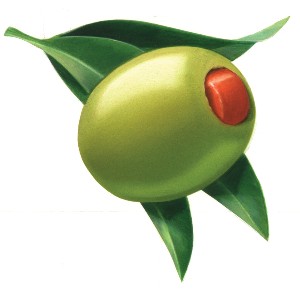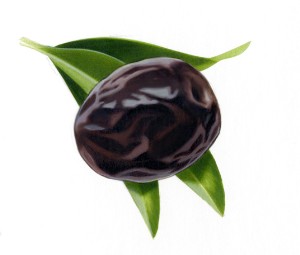Special Feature: Products Sally Recommends
Olive Styles & Varieties
 To begin with, botanically speaking, olives are a fruit. This may come as a huge surprise to some people (myself included) who suffer from the delusion that olives belong to the botanical family Garnish, comprising two sub-species, Olive greenus injars, and Olive nero incans. If you’re getting the idea that olives aren’t a staple item in my pantry, up until a few weeks ago you’d have been correct. Recently I decided to set aside old prejudices and try some recipes that include olives. I was amazed at the depth of flavor they lent to dishes. I wanted to know more.
To begin with, botanically speaking, olives are a fruit. This may come as a huge surprise to some people (myself included) who suffer from the delusion that olives belong to the botanical family Garnish, comprising two sub-species, Olive greenus injars, and Olive nero incans. If you’re getting the idea that olives aren’t a staple item in my pantry, up until a few weeks ago you’d have been correct. Recently I decided to set aside old prejudices and try some recipes that include olives. I was amazed at the depth of flavor they lent to dishes. I wanted to know more.
Since antiquity olives have been used to produce both food and oil. What makes eating olives particularly fascinating is that even when ripe, they are inedible without significant processing. What makes them so bitter is the glucoside known as oleuropein, a natural chemical constituent of olives. Curing leaches out the glucoside and leaves you with an edible fruit. Who would have thought to take something inedible and either soak it in water for months (water curing), soak it in lye and then salt brine for a week (lye curing), or pack it in salt for a few weeks (dry curing). Then, who had the nerve to taste it? Think about it, if you didn’t know what lobster tasted like and you plucked one out of the sea, would your first thought have been “ooh, let’s melt some butter”. Or would you have run from those claws screaming and taken up vegetarianism? You really have to take your hat off to those culinary adventurists.
 Olive trees grow best where they have mild winters and hot summers, so it’s no surprise they show up in Mediterranean cultures. Spain, Greece, Italy, France and Morocco; each have contributed their own speciality. In the United States, California has the largest plantings. Like most fruit trees (hard to believe you have to salt-cure a fruit!) olive trees bear perfumed flowers, usually between April and June. During this time, if the wind is too strong or the weather too cold, the crop yield will be small. Harvesting usually begins in September and can last through November. Olive trees have “alternating harvests”; one year the harvest is large and the next it will be small. Today, modern cultivation practices are able to minimize that effect. So just how many olives are we talking about? A Manzanilla olive tree growing in Spain might yield an average crop of 88 lbs. but during favorable conditions that number can reach 200 lbs. In the U.S., Lindsay Olive Company reportedly produces 10 million cases annually, making them the largest table olive producer worldwide. (Table olives are those meant to be eaten, as opposed to those which are processed into oil.)
Olive trees grow best where they have mild winters and hot summers, so it’s no surprise they show up in Mediterranean cultures. Spain, Greece, Italy, France and Morocco; each have contributed their own speciality. In the United States, California has the largest plantings. Like most fruit trees (hard to believe you have to salt-cure a fruit!) olive trees bear perfumed flowers, usually between April and June. During this time, if the wind is too strong or the weather too cold, the crop yield will be small. Harvesting usually begins in September and can last through November. Olive trees have “alternating harvests”; one year the harvest is large and the next it will be small. Today, modern cultivation practices are able to minimize that effect. So just how many olives are we talking about? A Manzanilla olive tree growing in Spain might yield an average crop of 88 lbs. but during favorable conditions that number can reach 200 lbs. In the U.S., Lindsay Olive Company reportedly produces 10 million cases annually, making them the largest table olive producer worldwide. (Table olives are those meant to be eaten, as opposed to those which are processed into oil.)
Trying to decipher exactly what olive you’re buying can be a tricky thing because industry lingo is anything but standard. Sometimes the same variety of olive will be cured using different methods to produce different styles. “It’s really very similar to the wine industry,” says Judy Rowcliffe, who represents Lindsay Olive Company. For example, the same Manzanilla variety olive can be cured using different methods to produce dramatically different styles. When lye-cured it will become a “green ripe” style. If lye-cured but also exposed to oxygen during the process, it becomes a “black ripe” style. Finally, if lye-cured then fermented in salt brine, it becomes the “Spanish” style.
 Ripeness of the olive can also be a factor. The same variety may be cured differently when picked mature green or tree-ripened. This is why you may see Picholine olives in both green and red-black colors. Dry curing is only done to tree-ripened fruit, and produces olive that have a wrinkled prune-like exterior (oops, sorry, must move with the times – wrinkled dried plum-like exterior) because the salt draws out the moisture.
Ripeness of the olive can also be a factor. The same variety may be cured differently when picked mature green or tree-ripened. This is why you may see Picholine olives in both green and red-black colors. Dry curing is only done to tree-ripened fruit, and produces olive that have a wrinkled prune-like exterior (oops, sorry, must move with the times – wrinkled dried plum-like exterior) because the salt draws out the moisture.
Olives come in different sizes, too. Some varieties produce small fruit while others produce larger fruit. Industry standardized sizing ranges from small (128-140 olives per pound) to super colossal (less than 33 per pound).
Here’s a list highlighting some of the more popular choices you’ll find in the grocery store.
STYLE: Green ripe; VARIETY: typically Manzanilla; METHOD: picked when mature but green, lye cured for approximately one week
STYLE: Black ripe; VARIETY: typically Manzanilla; METHOD: picked when mature but green, lye cured for approximately one week but have oxygen & organic iron added to the process; the oxygen turns them black & the iron allows them to stay black (who thinks of these things?…)
STYLE: Spanish; VARIETY: typically Manzanilla or Queen (Gordal, Sevillano or Ascolano varieties); METHOD: picked when mature but green, lye cured for just a few hours, then fermented in a salt brine for about 2 months. Stuffing pimento into these olives dates back to at least the late 1800’s.
STYLE: Sicilian; VARIETY: Sevillano; METHOD: picked when tree-ripe, natural cured in salt with lactic acid for one year
STYLE: Dry Greek; VARIETY: any grown in Greece; METHOD: picked when tree-ripe, dry cured
VARIETY: Kalamata METHOD: picked when tree-ripe, natural cured in salt for one year, purple-black in color
VARIETY: Nicoise METHOD: picked when tree-ripe, natural cured in salt for one year, brown-black in color
VARIETY: Gaeta METHOD: picked when tree-ripe, natural cured in salt for one year or can be dry cured, black in color
VARIETY: Picholine METHOD: picked when tree-ripe, natural cured in salt for one year, red-black in color
VARIETY: Cerignola METHOD: picked when mature but green, natural cured in salt for one year, green in color
A small amount of olives in your recipe can offer tremendous amounts of flavor. If desired, their saltiness can be reduced by rinsing or soaking in water. Nutritionally, olives are mostly fat, sodium & just a tiny bit of carbohydrates. Remember, their fat is mostly the monounsaturated type (after all, it is olive oil), valued in heart-healthy diets.
Leftover olives should be stored in the refrigerator, in the original brine (the salt & water solution which allows the olive to keep the saltiness it acquired during curing). If you’ve discarded that, mix ½ tsp salt with 1 cup water & store the olives in that. The olive companies say they will keep up to a week this way; I’ve had them in my fridge for much longer and noticed no ill effects; however if the olives become soft, they should be discarded. If you have a large quantity leftover and no immediate use in sight, rinse the olives, place in a container, cover with water and freeze for up to six months. Thaw and use within three weeks.
Note: This information was accurate when it was published. Please be sure to confirm all rates and details directly with the businesses in question before making your plans.



